The fragrance wheel serves as your essential guide for mastering scent creation and blending. You'll find it indispensable for understanding how different scent families interact, from florals to orientals, woody to fresh notes. It helps you identify complementary combinations, create balanced compositions, and develop sophisticated fragrances with lasting appeal. Whether you're a beginner or seasoned perfumer, this systematic approach reveals endless possibilities for your next signature scent.
The Evolution of the Fragrance Wheel
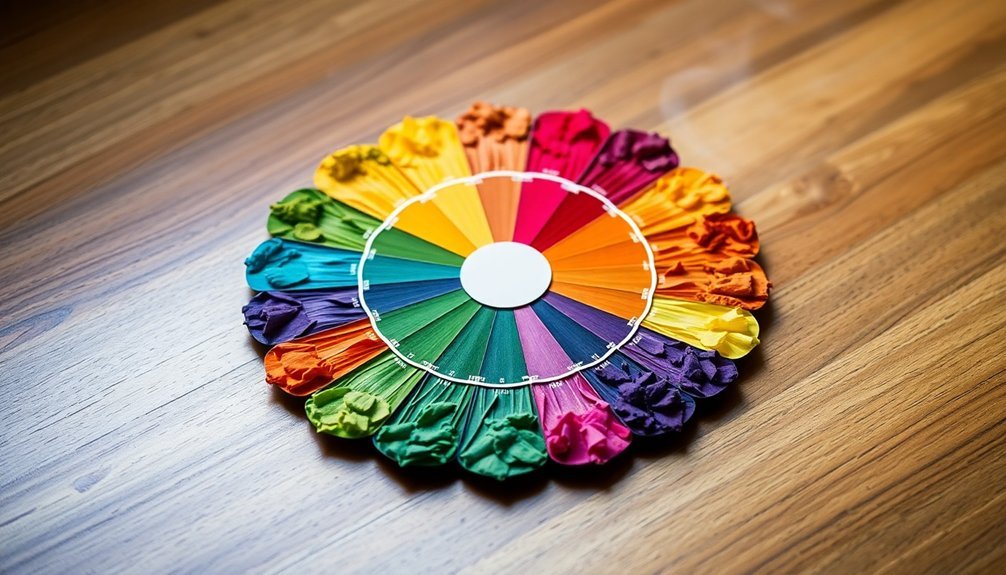
While many perfume enthusiasts use the fragrance wheel today, its development spans over seven decades of research and refinement.
It all began in 1949 when Paul Jellinek created the first version to map out scents based on their olfactory personality. This groundbreaking tool helped perfumers understand the relationships between different fragrances.
The wheel evolved considerably when U. Harder introduced the fragrance circle in 1979, bringing new perspectives to scent categorization.
However, it wasn't until 1992 that Michael Edwards revolutionized the concept by creating the modern fragrance wheel you know today. His design organizes scents into four main fragrance families: floral, oriental, woody, and fresh.
This systematic approach has become invaluable for identifying complementary and contrasting scents in perfume creation.
Mastering the Four Main Scent Families
To master perfume creation, you'll need to grasp the four foundational scent families: Floral, Oriental, Woody, and Fresh, each offering distinct characteristics for your fragrance palette.
You can enhance your perfume-making skills by learning how these families interact, such as how floral notes complement oriental bases or how fresh accords balance woody undertones.
Understanding these relationships allows you to mix scents confidently across families, creating unique combinations like citrus-oriental or woody-floral that appeal to modern preferences.
Understanding Basic Scent Categories
The perfume world revolves around four foundational scent families that create the building blocks of modern fragrances: floral, oriental, woody, and fresh.
When you're working with the fragrance wheel, you'll discover that each family has distinct characteristics that evoke specific emotional responses.
You'll find that floral fragrances capture the essence of fresh blooms, making them particularly appealing in women's perfumes.
The oriental family offers rich, exotic notes from spices and resins, while the woody fragrance family delivers warm, earthy undertones through ingredients like sandalwood and patchouli.
Fresh fragrances round out the wheel with invigorating citrus, aquatic, and herbal notes that work well in both men's and women's scents.
Understanding these basic scent families is essential for creating balanced and appealing perfume compositions.
Fragrance Family Compatibility Guide
Building on your knowledge of basic scent families, mastering fragrance compatibility opens up endless possibilities for creating unique perfume blends.
The fragrance wheel helps you understand how different fragrance families complement each other, allowing you to create sophisticated combinations.
You'll find that floral fragrances pair beautifully with oriental notes, creating luxurious, romantic blends. Woody fragrances can enhance both oriental and floral scents, adding depth and longevity to your compositions.
Fresh fragrances work exceptionally well with florals and light woody notes, offering versatility in both masculine and feminine perfumes.
When experimenting with combinations, start with adjacent families on the fragrance wheel for harmonious results.
You can gradually explore more contrasting pairings as you develop your expertise, keeping in mind that successful blending often relies on maintaining balance between complementary scents.
Mixing Between Scent Groups
Mastering the art of mixing between scent groups starts with understanding how each family's unique characteristics interact.
When you're working with the fragrance wheel, you'll find that adjacent scent families naturally complement each other. You can pair floral scents with fresh fragrances to create bright, uplifting compositions, while woody scents blend seamlessly with oriental notes for rich, sophisticated results.
Don't be afraid to experiment with contrasting families. Try combining light, fresh fragrances with deep oriental bases, or layer delicate florals with warm woody scents.
These opposing combinations often create the most intriguing and memorable perfumes. The key is to balance the intensity of each note, ensuring that stronger scents don't overpower lighter ones.
This understanding of scent families enables you to craft unique, well-balanced fragrances.
Understanding Fragrance Notes and Layers
To create sophisticated fragrances, you'll need to master the key differences between fleeting top notes like citrus and lasting base notes like musk and vanilla.
You'll find that while top notes give your fragrance its initial impact and fade within minutes, base notes anchor your creation and can persist for days on the skin.
Top Notes Vs Base
Every memorable fragrance tells a story through its carefully orchestrated layers of scents.
When you're working with the fragrance wheel, understanding the dynamic between top notes and base notes is essential for creating a balanced olfactory experience. Top notes greet your nose immediately but vanish within minutes, while base notes anchor your creation with lasting power that can persist for days.
- Top notes provide the initial impression, featuring light, volatile elements like citrus and delicate florals.
- Middle notes bridge the gap, emerging as the opening fades to reveal the fragrance's true character.
- Base notes deliver depth and staying power through rich woods, resins, and musks.
This interplay between fleeting and enduring elements creates a multi-layered journey that transforms throughout wear, making your fragrance truly unforgettable.
Building Complex Scent Layers
Building complex scent layers requires a deep understanding of how different fragrance notes interact and evolve over time. By using the fragrance wheel as your guide, you'll learn to combine aromatic elements that complement each other while creating depth and intrigue in your perfumes.
Start with bright, fleeting top notes like citrus or light floral scents that capture immediate attention.
Then, layer in middle notes that bridge the composition – these often include fuller floral or woody elements that emerge as the top notes fade.
Finally, anchor your creation with rich base notes that provide lasting character and complexity.
The key is ensuring each layer flows smoothly into the next, creating a harmonious blend that tells a complete olfactory story. Your mastery of these interactions will determine how beautifully your fragrance develops on the skin.
Essential Tools for Scent Classification
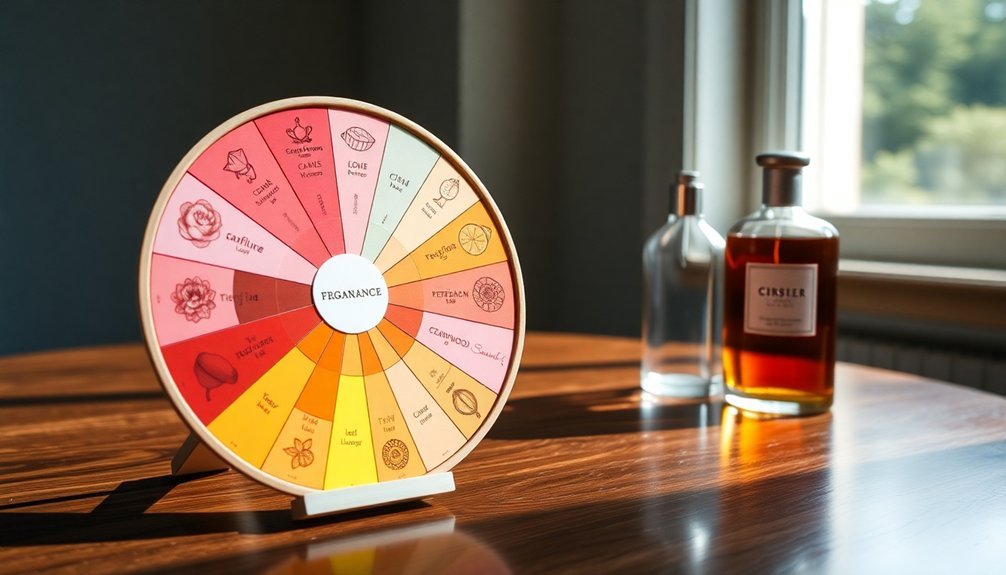
While creating enchanting fragrances requires artistic vision, success depends heavily on mastering essential classification tools like the fragrance wheel. As a perfume maker, you'll find this innovative system organizes scents into four main families—floral, oriental, woody, and fresh—making it easier to understand and classify your creations.
- The wheel helps you identify subfamilies within each scent category, allowing for precise fragrance development.
- You'll discover relationships between different scent families, enabling creative blending techniques.
- You can confidently recommend complementary scents to customers, enhancing their selection experience.
When you master the fragrance wheel, developed by Michael Edwards, you'll gain the ability to create more sophisticated and harmonious blends. This visual tool serves as your compass for traversing the complex world of scent classification and composition.
Blending Techniques Using the Wheel
You'll discover that adjacent notes on the fragrance wheel naturally complement each other, creating harmonious blends that share similar characteristics.
By selecting scents from neighboring families, you can build a foundation that feels cohesive and balanced in your perfume creation.
For more complex compositions, try the triangle method by choosing three subfamilies that form a triangle on the wheel, allowing you to craft sophisticated fragrances with layered dimensions.
Adjacent Notes Create Harmony
Creating harmonious fragrance blends becomes intuitive when you understand how adjacent notes work together on the fragrance wheel. By selecting scent families that sit next to each other, you'll create smooth shifts and balanced combinations that appeal to your target audience.
- Choose your primary scent family as your foundation, then explore neighboring subfamilies to enhance complexity.
- Blend adjacent notes like florals with fruity notes to maintain familiarity while adding depth.
- Use the wheel's structure to identify complementary characteristics that'll evoke specific emotions.
When you're working on fragrance formulations, you'll find that adjacent notes naturally complement each other, making your creative process more efficient.
The wheel's organized layout helps you predict which combinations will work best, allowing you to craft sophisticated scents that resonate with your customers' preferences and memories.
Triangle Method For Complexity
To develop sophisticated fragrances that transcend simple blends, the triangle method offers a strategic approach for combining three distinct subfamilies on the fragrance wheel.
You'll create complex scents by selecting notes that form a triangular pattern across the wheel, such as pairing floral, woody, and fresh elements.
When you use the triangle method, you're able to explore unexpected combinations that blend well while maintaining harmony.
This technique helps you push beyond conventional pairings to discover unique fragrance profiles that'll appeal to diverse consumer preferences.
By incorporating contrasting notes from different fragrance subfamilies, you're crafting multidimensional scents that stand out in the market.
The result is a sophisticated layering effect that creates depth and intrigue, making your perfumes more marketable and appealing to a broader audience.
Creating Signature Combinations
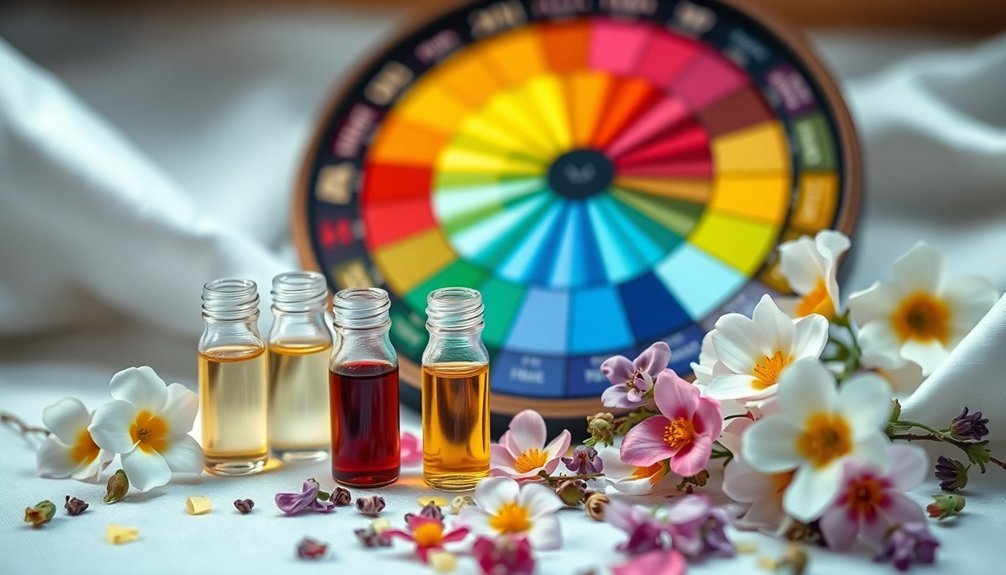
A master perfumer's palette comes to life through the strategic placement of scents on the fragrance wheel.
You'll discover endless possibilities for signature combinations by exploring different techniques to blend complementary notes. The neighbor fragrance technique lets you combine adjacent families, like floral notes with fruity accents, creating harmonious blends that feel natural and sophisticated.
- Pair opposing families on the wheel, such as floral notes with woody notes, to develop bold and unexpected signature scents.
- Use the triangle method to select three subfamilies, creating complex fragrances with multiple dimensions.
- Balance top, middle, and base notes from different wheel sections to guarantee your signature scent has lasting depth.
Exploring Complementary Scents
When you understand complementary scents on the fragrance wheel, you'll release powerful combinations that elevate your perfume creations.
As a perfume maker, you can access unique blends by pairing scent families positioned opposite each other on the wheel, such as Amber and Ozonic notes.
You'll find that complementary scents create complex and well-rounded fragrances by combining contrasting olfactory characters.
The fragrance wheel guides you in discovering these unexpected pairings, making your fragrance experience more diverse and intriguing.
By experimenting with opposite subfamilies, you can develop distinctive combinations that stand out in the market.
Don't limit yourself to traditional pairings.
Use the wheel to explore contrasting notes that, when combined, create harmonious and balanced compositions that resonate with your customers.
Advanced Fragrance Pairing Methods
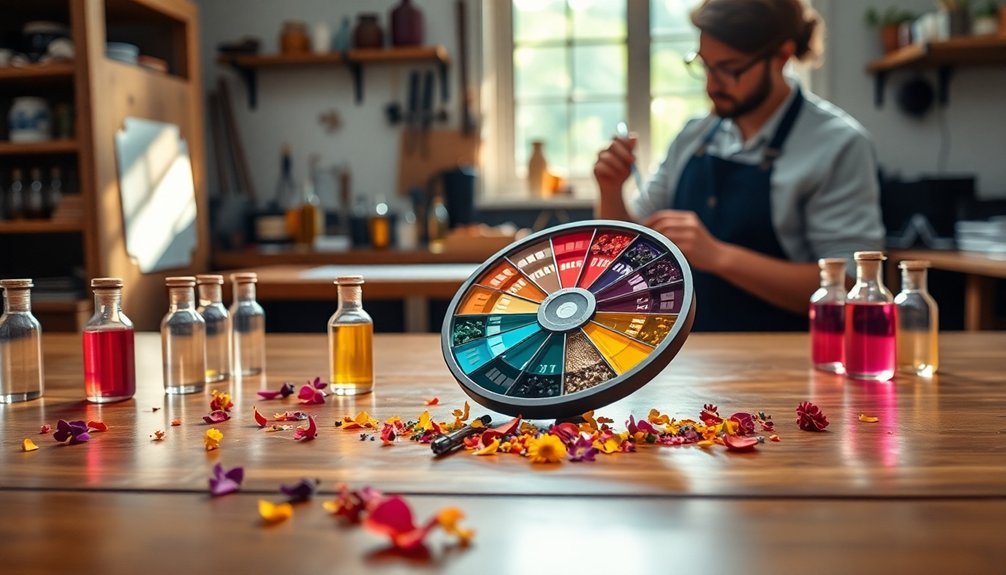
Building on the principles of complementary scents, advanced fragrance pairing opens up sophisticated techniques for creating distinctive perfumes.
The fragrance wheel serves as your essential guide for exploring complex aromatic notes and understanding how scent families interact. You'll discover powerful advanced pairing methods that elevate your perfume creation skills.
- Neighbor Technique: Combine adjacent subfamilies on the fragrance wheel to create harmonious complementary notes.
- Opposite Technique: Match scents from opposing wheel positions to develop intriguing contrasts.
- Triangle Technique: Select three subfamilies forming a triangle pattern to achieve balanced, multifaceted blends.
Seasonal Scent Selection Strategy
Mastering seasonal scent selection requires strategic use of the fragrance wheel to capture the essence of each season's unique characteristics. You'll find that understanding scent families helps you create perfectly balanced seasonal fragrances that resonate with your customers' preferences throughout the year.
| Season | Recommended Scent Families |
|---|---|
| Spring | Fresh florals, citrus notes |
| Summer | Light aquatics, green herbs |
| Fall | Woody ambers, spicy fruits |
| Winter | Rich orientals, warm vanillas |
| Holiday | Festive spices, sweet musks |
Professional Applications in Perfumery
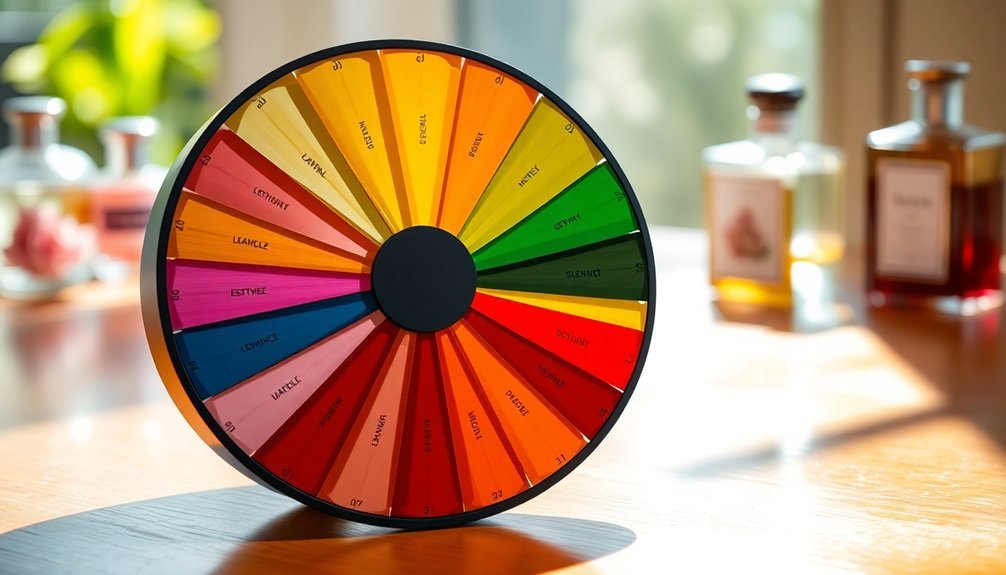
Professional perfumers rely on three fundamental applications of the fragrance wheel to create successful compositions: scent categorization, note harmonization, and blend development.
- You'll master scent families by utilizing the fragrance wheel's organized structure, helping you identify and classify fragrances within distinct categories like floral, oriental, woody, and fresh.
- You can discover complementary notes by exploring adjacent segments, enabling you to create harmonious blends that'll resonate with your target audience.
- You'll perfect the balance of top, middle, and base notes, ensuring your compositions evolve beautifully over time.
As you navigate the perfume industry, you'll find the fragrance wheel invaluable for communicating with clients and colleagues.
It's your essential tool for articulating scent characteristics and developing unique combinations through opposite fragrance techniques, making it indispensable for professional success.
Building Your Fragrance Library
As you commence your perfumery journey, a well-organized fragrance library becomes your creative foundation. Using the fragrance wheel as your guide, you'll be able to categorize and access scents efficiently, making your formulation process smoother and more intuitive.
Start by understanding complementary notes across different fragrance families. You can create unique scent combinations by exploring relationships between floral, oriental, woody, and fresh categories.
Your library should maintain a balanced representation of these families while staying current with emerging trends and discoveries.
Don't limit yourself to traditional pairings. The fragrance wheel empowers you to experiment with unexpected combinations, like blending floral oriental notes with fresh accords.
Frequently Asked Questions
What Is the Purpose of a Fragrance Wheel?
The fragrance wheel helps you understand scent relationships and categories by organizing them into families. You'll find it easier to identify complementary and contrasting scents, making it a valuable tool for fragrance creation.
What Is the 30 50 20 Rule for Perfume?
When you're creating perfume, you'll want to follow the 30-50-20 rule: use 30% top notes for first impressions, 50% middle notes for character, and 20% base notes for lasting depth and foundation.
Who Created the Fragrance Wheel?
You'll want to know that Michael Edwards created the fragrance wheel in 1983. He was inspired by Paul Jellinek's 1949 diagram, and his wheel has become the perfume industry's essential classification tool.
Why Use Roll on Perfume?
You'll love roll-on perfumes for their precise application, portability, and concentrated formulas. They're perfect for travel, won't spill, and let you control exactly where your fragrance goes while lasting longer than sprays.
In Summary
You'll find the fragrance wheel indispensable as you develop your perfumery skills. It's not just a classification tool – it's your roadmap to creating unique, balanced scents that resonate with your vision. By mastering the wheel's principles, you're equipped to blend confidently, select seasonally appropriate fragrances, and build a diverse scent library. Whether you're a novice or professional perfumer, this essential guide will transform your creative process.
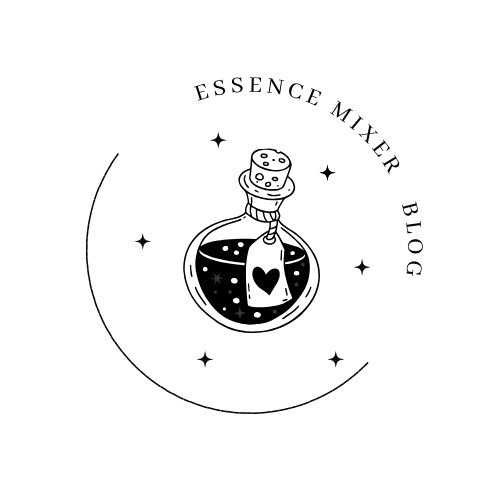
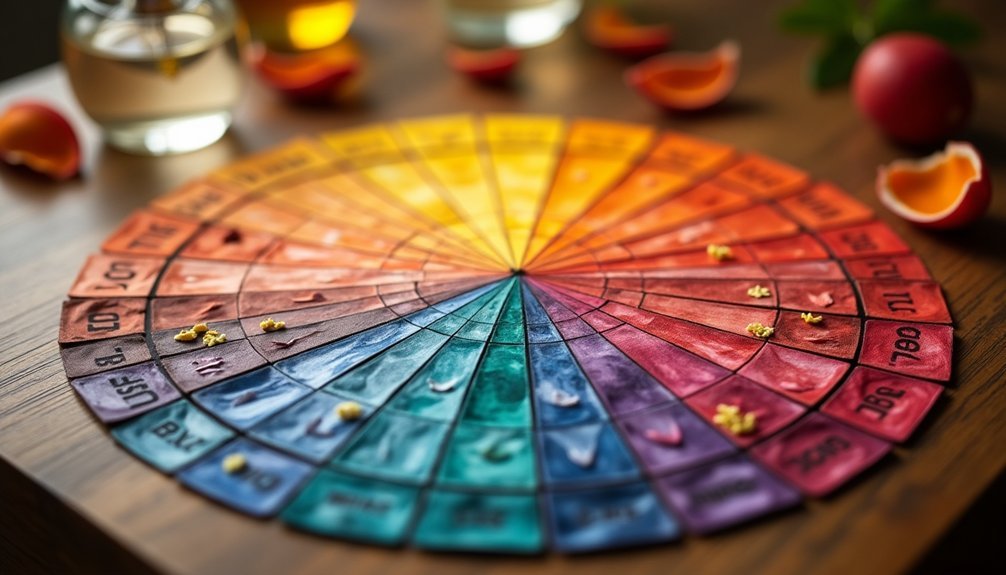



Leave a Reply